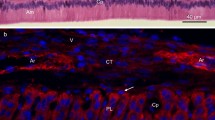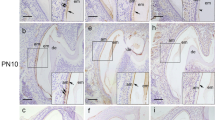Abstract
Tight junctions (TJs) function primarily as a barrier against paracellular transport between epithelial cells and are composed mainly of occludin (OLD) and claudins (CLDs). The CLD family consists of 24 members that show tissue- or cell-specific expression. Ameloblasts, which originate from the oral epithelium, form enamel, and enamel proteins and minerals are transported across the ameloblastic layer during amelogenesis. We immunohistochemically examined the distribution patterns of TJs in ameloblasts by observing the expression patterns of OLD and CLDs (CLD-1 to CLD-10). Secretory ameloblasts contained OLD and CLD-1, -8, and -9 at the distal end of the cell. In mature ameloblasts, OLD and CLD-1, -6, -7, -8, -9, and -10 were present mainly at both the distal and proximal ends of the cell, regardless of whether the ameloblasts were ruffle-ended or smooth-ended. Mature ameloblasts in which only the proximal ends were stained for OLD and CLDs were also found. These results indicate that the expression patterns of CLDs and the distribution patterns of TJs change drastically between the secretory and mature ameloblast stages, suggesting that these patterns reflect the different functions of these cells, specifically in the transport of proteins and ions for enamel formation.
Similar content being viewed by others

References
Takano Y (1995) Enamel mineralization and the role of ameloblasts in calcium transport. Connect Tissue Res 33:127–137
Smith CE (1998) Cellular and chemical events during enamel maturation. Crit Rev Oral Biol Med 9:128–164
Hubbard MJ (2000) Calcium transport across the dental enamel epithelium. Crit Rev Oral Biol Med 11:437–466
Furuse M, Hirase T, Itoh M, Nagafuchi A, Yonemura S, Tsukita SA, Tsukita SH (1993) Occludin: a novel integral membrane protein localizing at tight junctions. J Cell Biol 123:1777–1788
Furuse M, Fujita K, Hiiragi T, Fujimoto K, Tsukita S (1998) Claudin-1 and -2: Novel integral membrane proteins localizing at tight junctions with no sequence similarity to occludin. J Cell Biol 141:1539–1550
Furuse M, Sasaki H, Fujimoto K, Tsukita S (1998) A single gene product, claudin-1 or -2, reconstitutes tight junction strands and recruits occludin in fibroblasts. J Cell Biol 143:391–401
Furuse M, Tsukita S (2006) Claudins in occluding junctions of humans and flies. Trends Cell Biol 16:181–188
Sasaki T, Higashi S, Tachikawa T, Yoshiki S (1982) Formation of tight junctions in differentiating and secretory ameloblasts of rat molar tooth germs. Arch Oral Biol 27:1059–1068
Sasaki T, Higashi S, Tachikawa T, Yoshiki S (1983) Thin-section, tracer, and freeze-fracture study of the smooth-ended maturation ameloblasts in rat incisors. Acta Anat (Basel) 117:303–313
Sasaki T, Segawa K, Takiguchi R, Higashi S (1984) Intercellular junctions in the cells of the human enamel organ as revealed by freeze-fracture. Arch Oral Biol 29:275–286
Sasaki T, Segawa K, Takiguchi R, Higashi S (1985) Formation of tight and gap junctions in the inner enamel epithelium and preameloblasts in human fetal tooth germs. Acta Anat (Basel) 121:223–229
Hasty DL (1983) Freeze-fracture studies of neonatal mouse incisors. Anat Rec 205:405–420
Sasaki T, Garant PR (1986) A study of post-secretory maturation ameloblasts in the cat by transmission and freeze-fracture electronmicroscopy. Arch Oral Biol 31:587–596
Kawamoto T, Shimizu M (1990) Changes in the mode of calcium and phosphate transport during rat incisal enamel formation. Calcif Tissue Int 46:406–414
Eisenmann DR, Sarraj S, Becker SR, Zaki AE (1995) Ameloblast cycling patterns as measured by fluorochrome infiltration of rat incisor enamel. Arch Oral Biol 40:193–198
Kawamoto T (2003) Use of a new adhesive film for the preparation of multi-purpose fresh-frozen sections from hard tissues, wholeanimals, insects and plants. Arch Histol Cytol 66:123–143
Unda FJ, Pérez-Nanclares G, Le Morvan V, Hernández C, Vilaxa A, De-la-Fuente M, Gorry P (2003) Dynamic assembly of tight junction-associated proteins ZO-1, ZO-2, ZO-3 and occludin during mouse tooth development. Histol Histopathol 18:27–38
João SMA, Arana-Chavez VF (2004) Tight junctions differentiating ameloblasts and odontoblasts differently express ZO-1, occludin, and claudin-1 in early odontogenesis of rat molars. Anat Rec Part A 277A:338–343
Ohazama A, Sharpe PT (2007) Expression of claudins in murine tooth development. Dev Dyn 236:290–294
Inai T, Sengoku A, Hirose E, Iida H, Shibata Y (2008) Differential expression of the tight junction proteins, claudin-1, claudin-4, occludin, ZO-1, and PAR3, in the ameloblasts of rat upper incisors. Anat Rec 291:577–585
Author information
Authors and Affiliations
Corresponding author
Rights and permissions
About this article
Cite this article
Hata, M., Kawamoto, T., Kawai, M. et al. Differential expression patterns of the tight junction-associated proteins occludin and claudins in secretory and mature ameloblasts in mouse incisor. Med Mol Morphol 43, 102–106 (2010). https://doi.org/10.1007/s00795-009-0482-7
Received:
Accepted:
Published:
Issue Date:
DOI: https://doi.org/10.1007/s00795-009-0482-7



